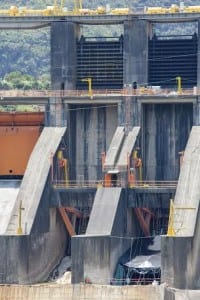Hydroelectric dams are giving Ecuador greater energy sovereignty
LiveTheLifeinEcuador | January 15, 2016
 The Manduriacu Hydroelectric Dam was officially inaugurated earlier this year. The 60-megawatt hydroelectric dam is located between the provinces of Imbabura and Pichincha, and is the first of eight dams currently being built in the country.
The Manduriacu Hydroelectric Dam was officially inaugurated earlier this year. The 60-megawatt hydroelectric dam is located between the provinces of Imbabura and Pichincha, and is the first of eight dams currently being built in the country.
About the Manduriacu Hydroelectric Dam
The Manduriacu Hydroelectric Dam features two 30-megawatt turbines and a reservoir with a capacity of 10 million cubic meters. Filling the dam to full capacity takes about ten days.
The hydroelectric dam provides over 2,450 jobs, and around 250,000 families benefit from the energy generated by the dam. As soon as the dam is fully functioning, it will reduce CO2 emissions by around 180,000 tons each year.
Many believe that the dam’s completion is the first step towards renewable energy in Ecuador, something that will greatly benefit the country.
The state expects to save around US$80 million annually in gas imports thanks to the dam, paving the way for greater energy sovereignty for Ecuador.
The Coca Codo Sinclair Hydroelectric Facility
Currently under development, the Coca Codo Sinclair is the largest energy project in Ecuadorian history. The giant 1,500-megawatt dam is located in the Amazon Basin, around 60 miles from Ecuador’s capital, Quito.
The dam is promoted as the centerpiece of the country’s new renewable energy plan, and is expected to generate an average of 8.63 gigawatt-hours each year – around 44% of the entire country’s energy needs.
The dam will create approximately 3,000 jobs, and will reduce CO2 emissions by about 4.5 million tons annually.
Completion of other hydroelectric dams
Once all eight dams are fully functioning sometime in 2016, they will collectively generate approximately 2,765 megawatts of energy, saving the country over US$3 billion on energy imports. The dams will create approximately 11,500 jobs, and will help Ecuador veer away from its status as an oil-based economy, eventually opening up opportunities for the country to become an energy exporter.

